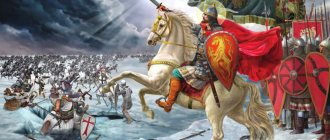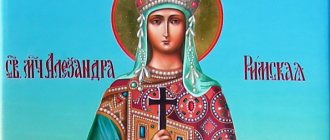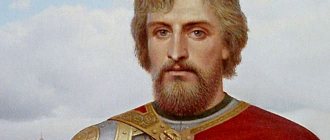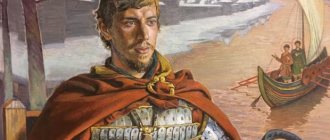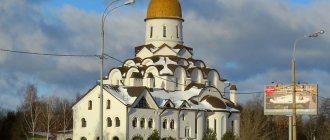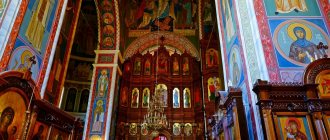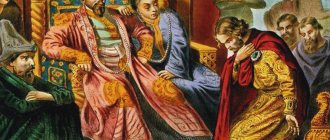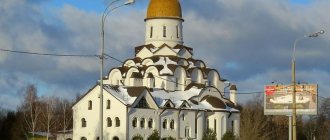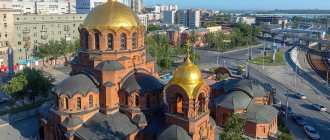Most modern people have heard the name Alexander Nevsky, but few have thought about why Prince Alexander was called Nevsky. And today we will try to answer this question, as well as consider a few more interesting points from the prince’s biography.
Alexander Nevsky was not only a prince, but also a commander. His biography includes many interesting and noteworthy facts, and we will pay attention to what he was called.
Why was Alexander Nevsky called Nevsky?
Prince Alexander, being an excellent tactician and commander, took part in many battles, but they named him Nevsky in honor of the Neva River, or rather, in honor of the battle on the river in which he took part.
History tells us that it was on the Neva that the prince accomplished a real feat, with only 200 fighters, he defeated an entire army of Swedes, including more than 2 thousand heads. A remarkable fact is that during this battle the prince himself managed not to suffer losses among his own squad.
Why was Alexander Nevsky called a saint?
In addition to the fact that Prince Alexander was given the nickname Nevsky, he was also called a saint. And why they began to call him that should also be told.
During his lifetime, Alexander Nevsky was a very respected person, since he was noted not only for his ability to fight and manage political affairs, but also had very good human characteristics, being a merciful and wise ruler.
All this led to the fact that after the death of the prince, with the publication of a literary work about his life, A. Nevsky was canonized. After this procedure was completed, he was quite justifiably and deservedly called a saint, and he is called that to this day.
Demanded by the Romanovs
The tsars from the Romanov dynasty who came to power continued to honor Alexander Yaroslavich, although, unlike the Rurikovichs, they were not his direct descendants. The Romanovs, who ascended the throne as a result of their victory over the Poles, also needed a symbol of the struggle against the West. Under them, around 1630, the first temple in Rus' in the name of St. Alexander Nevsky was erected in the Moscow Kremlin.
The image of Alexander Yaroslavich received a new meaning under Peter I, who declared him the “heavenly patron” of St. Petersburg of the reigning dynasty and the Russian Empire. Peter Alekseevich was the first of the Russian tsars to make Alexander his official heavenly patron. The first Russian emperor believed that he was born with Alexander on the same day - May 30. And Peter even named his son, born in 1691, in honor of his patron (although Alexander Petrovich died in infancy).
In 1710, at the confluence of the Chernaya River with the Neva, Peter personally chose a place to build a monastery in honor of Alexander Nevsky. This place has nothing to do with the chronicle Battle of the Neva, since the mouth of the Izhora River, where it took place, is located forty kilometers from it. But Peter needed a monastery in the capital itself, and not in its distant suburbs.
In 1723, the Holy Synod decided to transfer the relics of Alexander from Vladimir to the Alexander Nevsky Monastery (in fact, the remains that the monks of the Nativity Monastery passed off as the relics of the prince died in a fire back in 1491). The route was designed so that the ark with the shrine would pass through large populated areas. All this way, the cortege, guarded by an honorary military escort, moved surrounded by the clergy, crowds of people, beggars and fools.
Transfer of the relics of Alexander Nevsky by Peter I. (Wikimedia Commons)
The procession proceeded through Moscow, Tver, Novgorod. Further along the Volkhov to Lake Ladoga and the Neva. A month later, the ark arrived in the vicinity of the capital. At this point, the ceremony was interrupted for a whole year: Peter decided to arrange a solemn meeting of the relics on the next anniversary of the conclusion of the Peace of Nystadt. On August 30, 1724, the reliquary with the relics was transferred to a galley, the rowers of which were the highest state dignitaries. Peter took the helmsman's place.
Peter also came up with the idea of establishing an order in honor of Alexander Nevsky. But he did not manage to award this order to anyone due to his sudden death.
Martha Skavronskaya, who by the will of fate found herself on the Russian throne after the death of her husband under the name of Catherine I, trying to win the favor of her subjects, acted as the continuer of his affairs. Therefore, Catherine I celebrated her accession to the throne by awarding a new Order of the Russian Empire. The first holder of the order was the nephew of the Swedish King Charles XII - Duke of Holstein Karl Friedrich.
Empress Elizaveta Petrovna, emphasizing that she was continuing her father’s work, spared no expense on the Alexander Nevsky Monastery. Its main decoration was to be a new shrine. Elizaveta Petrovna ordered that ninety pounds of the first domestic silver, which was obtained from the Kolyvan mines, be given for its creation. Russian craftsmen from the Mint worked on the silver ensemble for almost three years. The epitaph inscribed on the sarcophagus was composed by Lomonosov. In it, the poet calls Alexander Yaroslavich “a zealous defender” who “tamed barbarism in the east and overthrew envy in the west.”
Alexander Nevsky Lavra, St. Petersburg. (Wikimedia Commons)
Beginning in 1743, by order of Elizaveta Petrovna, a religious procession was organized along Nevsky Prospect from the Kazan Cathedral to the Alexander Nevsky Monastery. From that time on, this ceremony was performed annually. The last such religious procession took place in 1916.
Since the 18th century, Alexander Nevsky finally supplanted all other princes canonized by the church in official veneration. The three Russian emperors who bore his name in the 19th century established the exclusivity of his veneration. During their reign, many churches dedicated to Nevsky were erected. In the churches of other saints, including in the main Orthodox cathedral of Rus' - the Cathedral of Christ the Savior, chapels of Alexander Nevsky appeared.
Why is the story called “The Life of Alexander Nevsky”
Thanks to the feat described above, and other remarkable facts from the life of the prince, his achievements and outstanding life, he deserved that a story was written about him. This work was published in the 13th century, and many people are interested in why it received this name.
However, the answer to this question is simpler than in the case of the origin of the nickname “Nevsky”, and is quite obvious. The story tells about just one hero, as well as the details of his life, his campaigns, battles, etc. And this hero, of course, is Alexander Nevsky. Therefore, the literary work received such a name.
Class! 10
Battle of the Neva - 1240
“God is not in power, but in righteousness!” - words spoken before the Battle of the Neva, which later became symbols of all military feats of the Russian people and gave the nickname “Nevsky” to Prince Alexander Yaroslavovich.
Chronology of the event:
- July 1240 - Swedish soldiers landed on the banks of the Neva and issued an ultimatum, which stated the unconditional obedience of Novgorod.
- July 1240 - repulse of the Novgorod prince, who gathered a small army for battle, consisting of cavalry and infantry.
- July 15, 1240 - a surprise attack on the Swedes and their total defeat.
Planning a crusade against Russian lands
In 1232, Pope Gregory the Ninth declared the spread and protection of Catholicism in his native and surrounding lands. However, soon the will of God began to be instilled not only with the help of sermons, but also with brute physical force. The rights of the Finns were limited - houses, plots, livestock and food were taken away. And the support of the disadvantaged people from the Russian lands only aggravated the situation, since the Pope was strenuously trying to protect the dissemination of the Catholic faith from Orthodoxy.
Interesting! Initially, the Western states did not plan a crusade against the lands of Rus', but the territories that interested them were also interested in Novgorod. For this reason, a clash between two different sides became inevitable.
Swedish troops in the Novgorod lands
In 1238, representatives of the Swedish, Danish and Teutonic states came together to hold foreign policy discussions regarding the invasion of Russian lands. However, the campaign, planned for the next year, for unknown reasons was postponed to the middle of the 13th century - the summer of 1240.
The army of the Swedes stopped on the Neva River and settled down at the very mouth. But the brave fighters were in no hurry to begin a bloody battle, since the commanders-in-chief of Royal Sweden were awaiting news from the allied states.
Interesting! At this time, the brave warriors coexisted peacefully with each other and even conducted trade negotiations with the peaceful local population, buying from them the necessary provisions, blacksmith equipment, or exchanging it for outlandish overseas things.
“God is not in power, but in righteousness!”
Alexander Yaroslavovich, who was only 20 years old in 1240, understood that the outcome of a possible battle would depend on his decisive actions, tactical plans and fearlessness. And first of all, the young prince of Novgorod decided to turn to his squad, great warriors and unstoppable fighters as defenders of Orthodoxy.
Important! Subsequently, his expression “God is not in power, but in truth!” became the motto that led people into battle eager to demonstrate the strength and inviolability of faith “in God, the Russian land and the prince, whose courage has no equal.”
The son of Yaroslav Vsevolodovich was not going to ask for help from neighboring states (especially from Vladimir). The people of Novgorod, Ladoga and Suzdal wanted to use their own resources to deal with those who invaded their homeland and wanted to encroach on the “Orthodox spirit.”
Surprise attack
At sunrise, Russian soldiers furiously attacked the camp of the sleepy and confused Swedes. The effect of surprise played into the hands of Alexander Yaroslavovich, since real chaos arose at the scene of the event, during which the soldiers of Royal Sweden began to run away to the ships.
In the inexplicable confusion, the troops of the Novgorod prince organized a brutal and bloody clash that lasted several hours.
As a result: the great Novgorod prince Alexander won an unconditional legendary victory over an entire army, having at his disposal only small detachments of horse squads and infantry.
Reply to the Roman Throne
In addition to armed attacks, Catholic Europe made numerous attempts to Catholicize Rus' through cunning and persuasion. Twice Pope Innocent IV sent messages in which he invited the prince to follow the path of his father, who allegedly agreed to submit to Rome. At the same time, papal pressure was exerted on Alexander Nevsky with the aim of joining forces with the Teutons to repel Tatar-Mongol attacks.
Interesting! The second papal letter speaks of the prince's alleged consent to join the Catholic Church. The Pope quoted Alexander Nevsky as follows:
“You have asked with all your earnestness to be included as a member of the one head of the church through true obedience.”
The prince's desire to build a Catholic church in Pskov was also mentioned. At the same time, the pope asked to accept the Archbishop of Prussia as his envoy. Finally, in 1251, two Catholic cardinals came to Novgorod with a bull. At the same time, in Vladimir, Alexander Nevsky’s brother Andrei married his future wife. The ceremony was performed by Metropolitan Kirill, a close associate of Prince Danil of Galicia, to whom the pope promised royal power back in 1246-1247.
Under the threat of an attack by the Teutonic knights, the Lithuanian prince Midovg accepted the Catholic faith. Despite such pressure, Alexander Nevsky remained unshaken. His answer to the pope was as follows: “We know everything that is good, but we do not accept teachings from you” (We understand everything, but we will not accept your teachings).
Already in 1251, the prince concluded an agreement with the king of Norway to resolve disputes regarding borders and the collection of tribute from a significant territory of the Karelian and Sami peoples. And in 1254, as a result of the obvious rapprochement between Rus' and Norway, the “Charter of Demarcation” was signed. Thus, Prince Alexander Nevsky significantly reduced the threat of military and Catholic expansion from the West.
Nevsky vs Lithuanians
In 1245, the Lithuanian army led by Mindaugas attacked Torzhok and Bezhetsk. Alexander and the Novgorod army took Toropets, where he killed almost ten Lithuanian princes. After the capture of Toropets, Alexander sent the Novgorodians home and on his own (with the forces of his court and squad) caught up with and completely destroyed the Lithuanian troops at Lake Zhitsa. On the way back, Nevsky defeated another Lithuanian detachment along Usvyatoy. Nevsky’s squad was a formidable force; the mere mention of him instilled fear in his enemies. Such glory could not fail to reach the Great Khan. Nevsky's father, Yaroslav, was sent to Karakorum, and Nevsky was “summoned” to the Horde to Batu.
